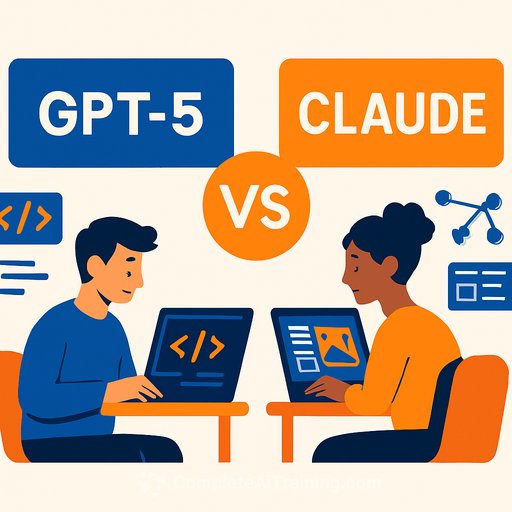GPT-5 vs Claude Code: AI Battle Royale
Creative Edge vs Precision
Two AI powerhouses—GPT-5 and Claude Code (with its Sonnet and Opus variants)—are challenging how code generation and app design get done. GPT-5 is known for sharp technical accuracy and consistent reliability. Claude Code, meanwhile, brings a creative spark and intuitive design sense that appeals to many developers and designers.
Choosing between them isn’t just about picking features. It’s about balancing creativity, functionality, and engineering quality. Which one fits your project depends on your priorities and the kind of output you need.
GPT-5 vs Claude Code TL;DR Key Takeaways
- GPT-5 delivers precision and reliability, ideal for engineering tasks with clear instructions.
- Sonnet and Opus lean into creativity and visual impact, better for design projects but may need tweaks for technical accuracy.
- Opus shines in producing clean, modular, maintainable code; Sonnet sometimes struggles with long-term code upkeep.
- When turning screenshots into functional designs, Sonnet and Opus outperform GPT-5, which is stronger with text-based specs.
- Clear, detailed prompts and iterative refinement improve results across all models.
Creativity and Reliability: Striking the Right Balance
Sonnet consistently produces creative, visually appealing results, making it a good pick for design-heavy projects. But it can miss key details, requiring extra polish. GPT-5, by contrast, has improved in dependability, producing accurate drafts with less rework.
Opus performs well in generating complex app pages but sometimes needs minor fixes. If your project emphasizes visual creativity, Sonnet stands out. For a reliable, balanced starting point, GPT-5 is catching up quickly.
Instruction Adherence: Precision or Intuition?
GPT-5 follows clear, detailed instructions closely, making it reliable when precision matters. Sonnet and Opus take a more intuitive approach, often making creative choices aligned with the bigger picture, but sometimes veering from strict guidelines.
Errors in first drafts are common across all models, so expect to refine outputs iteratively. If your work demands strict rule-following, GPT-5 is a solid choice. For tasks benefiting from creative flexibility, Sonnet and Opus may be preferable.
Code Quality and Maintainability: Engineering Standards Matter
Opus leads in producing clean, modular code structured around isolated, testable components—ideal for debugging and updates. GPT-5 also follows good engineering practices, with clear naming and separation of concerns.
Sonnet can generate clean code but sometimes struggles with modularity, which can complicate maintenance over time. For projects focused on maintainable code, Opus is the front-runner, with GPT-5 as a close second. Sonnet’s creative strengths may require more hands-on review.
Design and UI Implementation: Aesthetic Appeal vs Practical Functionality
Sonnet delivers visually polished, functional interfaces that align well with design goals. It’s a strong choice for projects where look and feel matter most. Opus offers innovative features like auto-progressing carousels but occasionally lacks design consistency.
GPT-5 tends toward straightforward, functional layouts that prioritize engineering needs over style. If aesthetics and design innovation are top priorities, Sonnet fits best. For practical, engineering-driven designs, GPT-5 provides a more utilitarian approach.
Using PRDs and Screenshots: Text and Visual Inputs
Detailed PRDs and screenshots boost performance for all models. Sonnet and Opus are particularly adept at translating visual references into working designs, making them valuable for UI/UX projects.
GPT-5 excels with text-based instructions but may need more iterations to handle visual design elements. When your project involves converting screenshots into code, Sonnet and Opus have the edge. For text-heavy, precise specifications, GPT-5 remains strong.
Key Insights for Choosing the Right Tool
- Clear, step-by-step prompts improve model performance dramatically.
- GPT-5 is best for engineering tasks needing exact guidance.
- Sonnet and Opus favor creativity and design but may need extra work for technical accuracy.
- Iterative testing and refining are necessary no matter which AI you pick.
Tailoring Your Approach for Maximum Impact
Your choice between GPT-5 and Claude Code depends on your project’s needs. GPT-5 suits engineering-focused work requiring precision. Claude Code’s Sonnet and Opus variants thrive in creative, design-driven tasks that need flexibility and visual intuition.
By matching each tool’s strengths to your goals, you can get the best results. Whether you want engineering rigor or creative freedom, these AI tools offer strong capabilities that, with the right prompts and refinement, can streamline your design and coding workflows.
For those interested in sharpening AI skills for creative and technical projects, exploring specialized courses can help build a deeper understanding of these tools. Check out Complete AI Training for resources tailored to both creatives and developers.
Your membership also unlocks:






